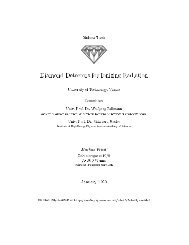Create successful ePaper yourself
Turn your PDF publications into a flip-book with our unique Google optimized e-Paper software.
Figure 3.2: Beam disposition at the LHC for proton operation [12].a final number of 2808 proton bunches or 591 ion bunches.Beam Life CycleAfter receiving a filling from the SPS, the LHC runs a “ramp up” program to acceleratethe beam up to the final energy, which takes approximately 20 minutes. Once the finalenergy is reached, the beam is kept in circulation while the luminosity steadily decays,principally through the effects of the collisions, but also through interaction with restgas in the beam pipe. This decay is modeled as an exponential decay of luminosityL(t) = L 0 e −t/τ Lwith τ L = 15 h. Once the luminosity becomes too low, the beam isaborted by directing it into one of the beam dumps. A controlled “ramp down” ofthe magnet system also takes about 20 minutes. Including the time spent in systemchecks and the LHC injection chain, the “turnaround time” between initiation of abeam abort and the availability of a new beam at full energy has been estimated tobe 70 minutes in the optimal case. This suggests a beam life of 5.5 hours to optimizeintegrated luminosity. A more pessimistic scenario assumes a sixfold increase in theturnaround time, which increases the optimal beam life to 12 hours.3.1.2 Proton-Proton OperationIn proton-proton operation, the LHC collides two proton beams at an expected centerof-massenergy of √ s = 14 TeV, with a design luminosity of L = 1.0 × 10 34 cm −2 s −1 .19












